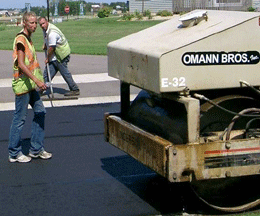June 26, 2009
Air Date: June 26, 2009
FULL SHOW
SEGMENTS
A New Take on Clean Water
View the page for this story
A recent 6 to 3 vote in the Supreme Court, ruled that fill material from mines will no longer count as pollution. In accordance, toxic tailings from mines can now be deposited directly into our waterways. Such dumping is set to happen at the Kensington gold mine in Lower Slate Lake in Alaska, not to mention into other waterways throughout the U.S. The ball is now in the Obama administration’s court— they can allow this dumping or revert back to a definition of fill material that fits the original intent of the Clean Water Act. Host Steve Curwood talks with the environmental lawyer, Tom Waldo, who argued this case before the Supreme Court. (06:00)
Bus Pass or Bus Fail
View the page for this story
Sliding into a seat on the city bus, you may think you’re doing your part to save the environment. But UC-Berkeley researcher, Mikhail Chester, compared the energy and emissions of trains, buses, airplanes, and cars and found this is not always the case. He shares his surprising results with host Steve Curwood. (05:10)
Carbon Capture
/ Ann MurrayView the page for this story
About thirty percent of America’s carbon dioxide emissions come from coal-fired power plants. And since coal is cheap and abundant, big energy companies are feeling pressured to produce so-called “clean coal.” This fall, American Electric Power will test-run the first carbon capture and storage project at an existing U.S. power plant. AEP boasts their carbon removal process is the technology of the future, but critics charge it’s untested, expensive, and doesn’t address the environmental problems of mining for coal. Ann Murray reports. (09:05)
Calculating Coal’s Toll
View the page for this story
Coal supporters like to point to the jobs and economic activity that coal mining brings to communities. But a new study argues the human costs of coal mining in Appalachia far outweighs its benefits. Michael Hendryx, a researcher at West Virginia University, talks with host Steve Curwood about coal's toll and policy options that would encourage richer, healthier communities in coal country. ()
Snow in Summer
/ Mark Seth LenderView the page for this story
Salt Marsh Diary’s Mark Seth Lender observes the brilliant white of the Snowy Egret does little to camouflage the bird, nor does it explain how the egret will survive the changing climate. (02:20)
Down in the Dumps
View the page for this story
The modern recycling movement started thirty years ago in an effort to reduce the amount of garbage going into landfills. It worked. In the process it also became a multi-billion dollar business, with thousands of new products being made out of recycled material. But the global recession has hit the recycling industry hard. Christine Parrish visits a recycling plant in Massachusetts to find trash that used to be turned into cash has sunk to junk value. (06:20)
An American Epic
View the page for this story
In 1804, the youngest member of the Lewis and Clark expedition got lost in the Great Plains for 16 days. Today, poet Campbell McGrath gives voice to the young man and his imagined adventures in a new epic, "Shannon: A Poem of the Lewis and Clark Expedition." Host Steve Curwood talks with McGrath about his hero's triumphs and losses as he wanders the prairie alone, among buffalo herds and under the big Western sky. (09:30)
This week's EarthEar selection
listen /
download
Show Credits and Funders
Show Transcript
Host: Steve Curwood
Guests: Mikhail Chester, Michael Hendryx, Campbell McGrath, Tom Waldo
Reporters: Ann Murray, Christine Parrish
Commentator: Mark Seth Lender
[THEME]
CURWOOD: From Public Radio International - this is Living on Earth.
[THEME]
CURWOOD: I’m Steve Curwood.
As protests heat up in coal country, new research shows the people who live and work there pay a bitterly high price for America’s huge appetite for coal.
HENDRYX: It seems like coal-mining areas in Appalachia are America's sacrifice zone, that their lives are expendable so that other people somewhere else can have cheap electricity.
CURWOOD: Also – transport of delight—how not to feel guilty about riding in an SUV or airplane. And an epic poem about an American epic journey, the Lewis and Clark Expedition.
MCGRATH: Buffalo buffalo buffalo buffalo - herds and eyes all around me in the darkness - buffalo in the dawn light breathing whispering - I am the buffalo god, I am the buffalo god – behold my kingdom!
CURWOOD: That and more - this week on Living on Earth! So stick around.
[THEME]
A New Take on Clean Water
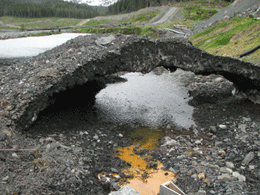
Acid drains from rock near Lower Slate Lake at the Kensington Mine. (Courtesy Of U.S. Forest Service)
CURWOOD: From the Jennifer and Ted Stanley studios in Somerville, Massachusetts, this is Living on Earth. I’m Steve Curwood.
Lead, mercury, caustic chemicals. These poisons make up part of the slurry from gold mining. Now, by 6-3 vote, the US Supreme Court has upheld a permit that allows a mine operation to dump its toxic tailings into the Lower Slate Lake in Alaska’s wilderness.
At the same time the high court said the Obama administration is free to revoke the permit, which was issued under rules adopted by the Bush administration. Tom Waldo is a lawyer for EarthJustice who argued against the mine at the Supreme Court.
Hi, Tom.
WALDO: Hi, Steve.
CURWOOD: Tom, before we ask you about the details of the case, what’s special about Lower Slate Lake?
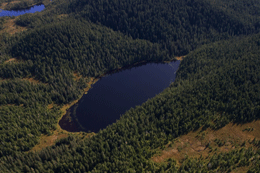
Lower Slate Lake in 2005, before mining operations. (Photo: Pat Costello)
CURWOOD: What exactly did the Supreme Court decide in this case? They ruled against you. They said “hey, the Bush administration ticked all the boxes that were necessary to issue a permit for the mine to put its leavings in the lake, describing them as fill. What was really decided in this case?
WALDO: Well, the Supreme Court upheld a permit issued by the Army Corps of Engineers that authorized the mining company to discharge 200,000 gallons per day of toxic wastewater pollution from a gold ore processing mill. The effect of the discharge would be to kill all of the fish and other aquatic life in the lake and over the ten-year life of the mine, the discharge would deposit four-and-a-half million tons of solids into the lake. And the Corps of Engineers did this even though EPA has had rules in place since 1975 that prohibit this exact kind of discharge.

Lower Slate Lake in 2006, after the surrounding trees were cut down and access roads built. (Photo: Pat Costello, Courtesy of Lighthawk)
WALDO: They did it by a ruse. They redefined the pollution as fill material. Now fill material is usually understood to be sand or gravel or rocks that are deposited in water for some useful purpose, like to build a levee or a sea wall or a bridge or made a building on wetlands. What they did during the Bush administration was they redefined fill material much more broadly so that it would encompass even pollution from industrial manufacturing facilities if it contains a lot of solids that could deposit on the bottom of a water body. That’s what they did here, and that’s what the Supreme Court upheld.
CURWOOD: How consistent was this ruling with the intent of the Clean Water Act, do you think?
WALDO: It’s not consistent at all. The intent of the Clean Water Act is to make waters fishable, swim-able, and drinkable again. The purpose of the act was to stop the practice of using lakes and rivers and streams as industrial waste dumps, but that’s exactly what the Army Corps of Engineers authorized here. They authorized the mining company to use Lower Slate Lake as a waste dump. It’s entirely contrary to the purposes of the Clean Water Act, and there’s just a crying need for Congress and the administration to act to correct this problem.
CURWOOD: The mine deposits from Kensington could raise the lakebed there some fifty feet and eventually triple the lake size to sixty acres. How would this raise in water level change the lake’s ecosystem?
WALDO: Well, it would change it into a much larger and shallower lake. The entire bottom of the lake would be filled up with mine tailings. When they were going through the process of preparing these permits, they tested some sample mine tailings to see what effect they would have on the fresh water life that lives in the lake and found that it was highly toxic. So, it will be a long and difficult process for this lake ever to recover if it is ever possible.

Acid drains from rock near Lower Slate Lake at the Kensington Mine. (Courtesy Of U.S. Forest Service)
CURWOOD: You’ve lost in the Supreme Court, but you say the fight’s not over.
WALDO: Oh yeah. Like I said, we’re continuing to ask the Obama administration to fix the problem underlying this case through new regulations defining fill material. We would like Congress to act on the Clean Water Protection Act. And in the meantime the administration has the authority to rescind the Kensington Mine permit. EPA can veto that permit under its rules and the Corps of Engineers can rescind that permit under its rules, and we hope the administration will do that.
CURWOOD: Tom Waldo is a lawyer for Earthjustice. Thank you so much.
WALDO: It’s a pleasure.
Related links:
- Click here to read the Supreme Court ruling.
- Earth Justice
[MUSIC: Nine Yards Orchestra “Sleep Waltzing” from Our Backyard (Groove Attack 2002)]
Bus Pass or Bus Fail

Empty buses can be a major emitter of air pollution as well as energy hogs. (Photo: Andreas Solberg)
CURWOOD: Sliding into a seat on a city bus, you may think you’re doing your part to save the environment. But a new study suggests that this is not always the case—riding public transit may not necessarily result in greater energy efficiency and cleaner air.
To evaluate the energy use and air pollution of various types of transportation more accurately, UC Berkeley researcher Mikhail Chester says that you need to take into account the entire life cycle, including infrastructure and maintenance.
Mikhail Chester is co-author of a recent study published in the journal Environmental Research Letters. The Berkleley team compared the energy and emissions of trains, buses, airplanes, and cars and found some unpredictable results.
CHESTER: One of the biggest surprises was not on the energy and CO2 side, but on the criteria pollutants side, sulfur dioxide, carbon monoxide, particulate matter, ground level ozone formation, you know, asthma rates in children, you know, these sort of things that contribute directly to human health impacts and environmental impacts. And the most surprising impact was that for a lot of these emissions, the bulk of them are not occurring at the vehicle’s tailpipe, but in these lifecycle components.
CURWOOD: So maybe not so much the car or bus, but the making of the road. Maybe not so much the train in operation, but the making of that train, the construction.
CHESTER: Absolutely. We’ve three million miles of roadways in the U.S. and what is the environmental impact of that – not just from an energy and CO2 perspective, but from these criteria pollutants I mentioned before. We’ve done a lot to sort of improve the tailpipe, what’s coming out of the tailpipe.
But when you don’t look at the tailpipe, when you look at all these lifecycle components you find that often they’re now the majority of the environmental burden. So, for roadways for example, there’s a lot of particulate matter released in the construction of roadways. When you construct a road you have to mine aggregate for the asphalt. You need to transport and process that material. You need energy to process that material and then you need to place the material. And all of these steps produce particulate matter along the way, and that turns out to be very large.CURWOOD: And the other major finding here is how much occupancy really affects things. So, if I look at your research carefully, seems to me that if I were driving a big honking SUV that say only got 12 miles to the gallon, but I took three other people with me, I’d be better off than driving a stingy say Honda hybrid that got 35 miles to the gallon just myself.
CHESTER: Right. And I think you should put that if in italics underline and bold, because that’s the important word there. But, yeah, that is correct. You know, this is – we should put it in context though. So SUVs are not being driven with three passengers in then. However, right – if you put three passengers in it and you compare it against a sedan with one passenger in it, it may be better off. I don’t think this is saying you should go out and buy SUVs, this is saying, you know, if you can get three passengers in it, that you’re better off than driving multiple sedans with one passenger in it.
CURWOOD: So, Mikhail, I’m looking at your study that you published and you have a really interesting set of charts in here, and one of them shows that an urban bus off-peak is probably the most energy intensive and greenhouse gas intensive way to go. It takes more than cars, even planes.

Empty buses can be a major emitter of air pollution as well as energy hogs. (Photo: Andreas Solberg )
CURWOOD: So, as a consumer, concerned consumer, worried about one’s energy footprint, seems to me that we should take solace when the bus is jammed. When you can’t get a seat, that’s a good thing for the environment.
CHESTER: I would think so, yeah.
CURWOOD: And likewise, if the plane is packed and you’re, you know, three or four of you to this row that was designed for children, again, this is more efficient.
CHESTER: Well, it is more energy efficient. Whether it’s comfortably efficient or ergonomic I don’t know.
[LAUGHING]
CURWOOD: Mikhail Chester is a researcher in the civil and environmental engineering department at UC Berkeley.
[MUSIC: Jenny Scheinman “Hard Sole Dance” from Crossing The Field (Koch Records 2008)]
CURWOOD: Coming up: today coal supplies half of the electricity in America– but unless we can give it a good and cost-effective cleaning, its future may not be burning bright.
It’s not just the problem of climate change that’s giving coal a black eye - new research has found that for residents in Appalachian mining country, the costs of the fuel far outweigh its benefits:
HENDRYX: One of the estimates translates into over 42 billion dollars, as the human cost of coal mining in Appalachia, some of the estimates are as high as over 80 billion dollars. The benefits of the coal economy measured by not just the direct jobs created but the indirect jobs that ripple through the economy as well as the severance taxes that are paid by coal companies, came to about 8 billion dollars a year.
CURWOOD: Counting up the true cost of the cheapest fuel. Keep listening to Living on Earth.
Related link:
Read more about the study on life cycle transportation emissions.
Carbon Capture
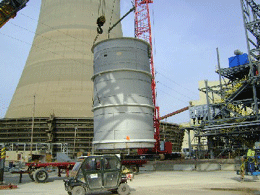
A carbon capture absorber is put in a power plant. (Courtesy of American Electric Power)
CURWOOD: It’s Living on Earth, I’m Steve Curwood.
Today the cheapest, most common way to generate electricity in the U.S. is the burning of coal.
But that poses health problems, and calorie for calorie, burning coal spews out three times as much of the greenhouse gas CO2 as the cleanest fossil fuels. And that has put coal under fire in the face of threatened climate disruption.
The Obama Administration recently revived FutureGen, a research project designed to show that a coal power plant can run cost-effectively without releasing CO2. And now there's a company that's becoming the first in the U.S. to retrofit an existing coal plant with carbon capture and storage.
Reporter Ann Murray has the story.
[TRUCKS BEEPING AND MOVING]
MURRAY: On a recent afternoon, trucks haul coal to a colossal storage pile at the Mountaineer power plant in New Haven, West Virginia. Each year, Mountaineer and 19 other plants owned by American Electric Power burn more than 75 million tons of coal to make electricity. Burning all that coal releases millions of tons of carbon dioxide. Mike Morris, American Electric Power’s CEO, says his company started thinking about that environmental connection years ago.

A view from the east of the Mountaineer Carbon Capture and Storage project. (Courtesy of American Electric Power)
MURRAY: Morris believes a carbon emission policy is in the cards for the United States. He’s betting AEP will reduce its carbon footprint with carbon capture and storage. His company’s pilot project will start up this fall at the 29-year-old Mountaineer plant. It'll be the first time an operating coal-fired power plant will capture and bury CO2 emissions.
[CONSTRUCTION WORKERS RIVETING STEEL]
MURRAY: Dozens of construction workers are now on site putting the pieces of the technology together.
SPITZNOGLE: They got a lot of steel on the ground and there’s still a lot more building left to do.
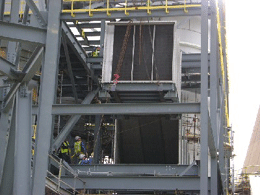
Workers install equipment at the Mountaineer CCS project. (Courtesy of American Electric Power)
SPITZNOGLE: The predominant thing you see is a big round tower that’s being built. That’s where the absorption happens.
MURRAY: Some of the plant’s emissions will be diverted to this five-story high tower. A chilled ammonia-based solvent will absorb the carbon dioxide there. Then the solvent will be heated to dissolve the CO2 out of the emissions. Spitznogle predicts this process will be a lot more energy efficient than other chemical absorption systems.
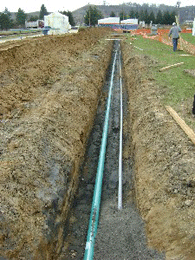
CO2 transport line at AEP's Mountaineer facility. (Courtesy of American Electric Power)
MURRAY: The CO2 will be compressed into a liquid, piped a short distance and injected into a deep storage well.
[SOUND OF GATE OPENING]
MURRAY: Back on the ground, Spitznogle opens a gate next to the wellheads. He says deep layers of porous rock will hold the CO2. Thousands of feet of dense shale above that will keep it in place. Nobody knows for sure if the gas will stay trapped permanently.
MURRAY: Why are you guessing that this is going to work?
SPITZNOGLE: Well, I wouldn’t use the term guess. This is kind of an extrapolation of what’s been done in the oil and gas industry for enhanced ore recovery. They actually inject CO2 and use it to push oil out of the ground.
MURRAY: AEP and a partner have invested 100 million dollars in this phase of the project. If it’s successful, the company hopes to get government help with the 300 to 500 million dollars needed to capture about 20 percent of Mountaineer’s CO2 . AEP’s ultimate plan is to fully retrofit one of their plants and capture 90 percent of its carbon. At every stage, the company believes it will take 15 to 20 percent of the plant’s power output to run the process. Energy analysts say the completed system could cost around a billion dollars. Even at that price, Mike Morris is convinced this carbon capture and storage technique will be cost effective for his company and other existing coal-fired power plants.

Part of carbon capture absorber being put into place at American Electric Power's Mountaineer facility. (Courtesy of American Electric Power)
MURRAY: Not every power company wants to make that leap. Some say that the technology is too expensive to perfect. Duke Energy, a major electricity provider, recently announced that it’s betting on nuclear power instead of pursuing carbon capture and storage. American Electric Power and the independent Electric Power Research Institute predict once their carbon capture system is fully operational, customers will pay about ten cents a kilowatt-hour. That’s five cents more than the cost of electricity from traditional coal-fired plants. And it’s three to four cents higher per kilowatt-hour than nuclear-powered energy and subsidized wind generation. Many industry experts anticipate the expense of building and running carbon capture systems at a commercial capacity will delay widespread use of the technology for several decades.
Some environmental groups object to the technology because of the harmful impacts of mining. Raina Rippel is the director of the Center for Coalfield Justice, a grassroots organization.
RIPPEL: This idea that carbon capture and sequestration is this silver bullet is just false. It doesn’t address the whole coal cycle. It doesn’t address the fly ash. It doesn’t address the mining impacts. It’s almost too little too late.
MURRAY: Rippel deals with the impacts of mining every day.
[BIRDS CHIRPING AND DOG BARKING]
MURRAY: Today, she’s in a neighborhood in southwestern Pennsylvania located above a Longwall mine. Longwall mining operations remove huge panels of coal buried deep underground. That causes the land above the mined area to drop. Aimee Erikson’s house dropped six inches days after her property was undermined. She shows Rippel raw sewage in her yard.
ERICKSON: The septic tank is located in the corner of my house where the house dropped the most. Smelling this constantly is disgusting.
MURRAY: Coalfield Justice’s Rippel says she sees hundreds of people like Amy Erikson with mining damage to their homes, businesses and water supplies. She believes investing in carbon capture and storage technologies will only slow down the transition to cleaner, low impact energy sources.
RIPPEL: I just think that carbon capture and sequestration is the anti-vision. It will tie us to the past.
RUBIN: As much as we wish we could wave a magic wand and replace fossil fuels with so-called clean renewables, there is no such magic wand.
MURRAY: Ed Rubin is a professor in Carnegie Mellon University’s Department of Engineering and Public Policy. Rubin sees coal as a major player in the US energy mix for decades. He isn’t nearly as sure that the widespread use of carbon capture at coal-fired plants is at hand. He says that two things have to happen to push the technology. First, the entire process: carbon capture, transport of the CO2 and storage must be shown to work safely and effectively at a commercial scale.
RUBIN: The second is public policy. Right now there’s no requirement for power plants or for anybody else for that matter to reduce CO2 emissions.
MURRAY: Some energy experts predict it could take 10 to 20 years and cost billions to learn if carbon capture and storage is commercially viable. Currently, Congress and President Obama are in the process of moving legislation to curb CO2 emissions. American Electric Power’s Mike Morris believes legislation will encourage carbon- limiting technologies and he’s on board.
MORRIS: It is not inexpensive. But it is doable. And society - American society, needs to decide that’s the way they want to go.
MURRAY: In the meantime, the federal stimulus package includes 2.4 billion dollars for "clean coal" projects. And the Department of Energy has offered at least six billion dollars in loan guarantees for existing coal-fired plants that use carbon capture and storage--signs that the pieces of the carbon capture puzzle might be falling into place for companies like American Electric Power.
For Living on Earth, I’m Ann Murray.
Related links:
- American Electric Power on Carbon Capture & Storage
- Center for Coalfield Justice
- Read Professor Ed Rubin’s biography.
Calculating Coal’s Toll
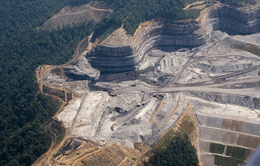
Mountain-top removal in West Virginia.
CURWOOD: But even if it proves to be economical to capture carbon, controversy still dogs coal.
Campaigners – including actress Darryl Hannah and climate scientist James Hansen - have taken their protests to West Virginia’s coal country and gotten arrested – why?
HANSEN: First we believe that no child’s health and safety are expendable for the expediency of a dirty energy source.
HANNAH: First of all to bring attention to the devastating effects of mountain top removal and to make a call for clean renewable infinite energy resources which we have available to us now.
[SHOUTING]
CURWOOD: At the same time, some West Virginians who depend on coal for their livelihoods hollered at the protesters to go back home.
PRO-COAL PROTESTER: They don’t like coal, they need to leave our state…
[CHANTING: “GO BACK HOME, GO BACK HOME”]
CURWOOD: But new research from the University of West Virginia suggests those who live and work in mining areas might want to rethink their allegiance to coal.
Michael Hendryx, a researcher in community medicine at West Virginia University has just published a study finding that coal costs a lot more in human terms than it provides in jobs and income.
HENDRYX: We did an analysis that showed that the areas in Appalachia where coal mining takes place actually have the weakest economic circumstances. They have the highest poverty levels, the highest unemployment levels, the lowest income levels. So we followed up that analysis by trying to come up with an estimate of both the cost and the benefits of mining for the Appalachian region and concluded that the costs outweigh the benefits by several factors.
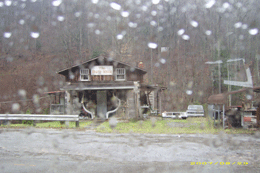
West Virginia coal country. (Courtesy of Michael Hendryx)
HENDRYX: The way that the value of statistical life or VSL is estimated is through I think a pretty ingenious type of a study design where you ask people, “suppose there was an illness that had a one in 10,000 chance of killing you. How much would you be willing to spend yourself to eliminate that risk?” And let’s say that people on average in a given study say $600, which a type of a reasonable or typical estimate that people will give. Then ten thousand people together will spend six million to save one life. So it’s a way to estimate what society itself values. And we used a range of those estimates and then looked at the number of excess deaths that occur every year in coal mining areas of Appalachia versus non-mining area.
CURWOOD: 10,000 excess deaths.
HENDRYX: That’s right. The years 1997 through 2005, translate to over 10,000 excess deaths every year, and we attribute that difference to higher poverty rates in mining area, and also to differences probably in environmental exposures and pollution from activities in the mining industry.
CURWOOD: And if you translate that into money, how much are you talking about?
HENDRYX: One of the estimates that I think is probably most reasonable to use translates into over $42 billion dollars as the human cost of coal mining in Appalachia. Some of the estimates are as high as over $80 billion dollars.
CURWOOD: And how much in the same period of time was the coal economy itself?
HENDRYX: The benefits of the coal economy measured by not only the direct jobs that it creates but the indirect jobs that ripple through the economy as well as the severance taxes that are paid by coal companies came to a little bit over $8 billion dollars a year, much lower than the estimated costs.
CURWOOD: Can you describe a couple of these communities? Paint a picture for us.
HENDRYX: Well, the first image that comes to mind maybe is a town called Whitesville in Boone County. If you drive through the downtown of Whitesville, you’ll see that there will be coal dust on the buildings themselves, on the outdoor furniture, on the vehicles. You’ll notice a lot of empty storefronts and empty streets and not a lot of business or economic activity taking place. I don’t want to pick on one town, but that’s the one that comes to mind. I don’t want to pick on the people that live there because they’re wonderful.

Dust from coal on the side of a house. (Photo: Penny Loeb)
HENDRYX: Well, I would disagree with that on ethical and moral grounds. But, some people who live there view that their lives are valued less than people who live somewhere else, and that in a way its hard to argue with that. It seems like coal-mining areas in Appalachia are—to us a phrase that’s been used “America’s Sacrifice Zone” That their lives are expendable so other people somewhere else can have cheap electricity. I find that appalling.
CURWOOD: The federal government’s gonna put a lot of money into carbon capture and sequestration from coal fired power plants. How advisable do you think that program is in light of your research?
HENDRYX: I think its one of the dumbest things that they’ve ever attempted to do. I don’t think the evidence is very good that we can implement a scalable carbon capture and storage system that can really be a serious way to deal with CO2 emissions. But even if we could, that addresses only how coal is burned. It doesn’t say anything about how it’s extracted, processed or transported prior to burning. And carbon capture and storage systems will do nothing to change the conditions in coal mining areas of Appalachia. We have to realize as well that the estimates that come out from the U.S. Geological Survey are that West Virginia will peak in a its coal production in probably less than twenty years. So we really don’t have any choice. We can sit around and do nothing and wait for that to happen, or we can begin now to plan and implement serious economic diversification programs. I think that should be a top priority for the state and the nation and even the local community leaders.
CURWOOD: Michael Hendryx is Associate Professor in the Department of Community Medicine at West Virgina University. Thank you so much, Sir.
HENDRYX: Thank you.
[MUSIC: Brian Blade “Her Song” from Mama Rosa (Nonesuch Records 2009)]
Related links:
- Click here to Living on Earth’s series, “Generating Controversy: The Changing Climate of Coal.”
- For more on Michael Hendryx, click here.
-
Snow in Summer
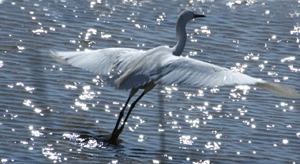
The Snowy Egret (Photo: © Salt Marsh Diary)
CURWOOD: White is not a color of camouflage except in a land of snow and ice. And yet, for the Snowy Egret, a bird that flies south to escape winter, it is the only color – observes writer Mark Seth Lender.
LENDER: The Snowy Egret lands, the name and color of a substance she will never see. There on the muddy bank, still as chalk her carved and ancient figure stands stilting. Like Nike, she leaps sailing into the bright, wide-winged above the shallow water where she feeds, so white sunlight seems shadow.
What could be the purpose of such brilliance, Snow in Summer. Perhaps in some prior life this most strident, most absolute of colors kept her safe in a far and frigid land, and all these amazing feathers are only an artifact of dim ice ages past. Or in the brief season between her comings and goings this is her temporary color, as polished and transparent as paper made of rice, except there is no other phase than white when Egret flies.
There is fragility in all this. The bird, the salt marsh where she lands, even the turbulent sand. From the South the assault comes by hurricane, each season earlier and more ferocious than the last. From the North it is the melting, and where there is no flood, drought. There is no reprieve. As the brackish plain is silted out or altogether gives way, where will Snowy Egret go? How will she retreat from Winter when Winter itself is in retreat?

The Snowy Egret. (Photo: © Salt Marsh Diary)
[MUSIC: Goldfish “Snow” from Coming Home (Pale Music 2008)]
CURWOOD: Mark Seth Lender writes the syndicated column “Salt Marsh Diary.” To see some of his photographs and find out more about his writings, go to our website, loe.org.
Just ahead: Lewis and Clark through the eyes of a lost land and transformed into epic verse. Stay with us- on Living on Earth.
Related link:
Salt Marsh Diary
Down in the Dumps
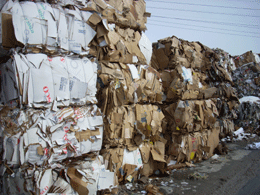
Bales of used cardboard stored behind North Shore Recycled Fibers wait in stacks as the global recycling market struggles to recover. (Photo: Christine Parrish)
CURWOOD: It’s Living on Earth, I’m Steve Curwood.
[SOUND OF RECYCLING TRUCK]
CURWOOD: It’s a familiar scene played out on streets across America.
[SOUNDS OF CANS BEING TOSSED INTO TRUCK]
CURWOOD: Workers in recycling trucks grab colorful curbside bins stuffed with cans, bottles and paper.
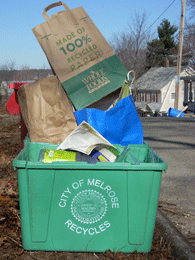
Putting recyclables out by the curb is only the first step in a global supply chain. (Photo: Christine Parrish)
CURWOOD: This is a crucial leg of a round-trip - from consumer to manufacturer and back again to the consumer. These days over 30 percent of household trash is recycled, according to the Environmental Protection Agency
But a funny thing has happened on the way to the reprocessing centers. The floundering global economy has trashed the market. Christine Parrish reports.
PARRISH: The modern recycling movement began as a personal virtue, an earth-friendly civic duty—but today it’s a multi-billion dollar business.
Jerry Powell is editor of: Resource Recycling Magazine.
POWELL: Recycling is one of the most popular environmental movements ever, so when you have 70 percent of people in a community recycling, I think the elected officials will try desperately to keep that program going.
PARRISH: During the economic boom times of the past decade, recycling was a boon to local governments, and to the recycling industry, which made big money grinding up recyclables into the raw materials that are used to make thousands of items, from t-shirts and surfboards to living room carpets.
GOLD: Hi Timmy.
PARRISH: Johnny Gold knows his way around the North Shore recycling plant in Salem, Massachusetts. His grandfather started the business in 1916 and sold it much later. But Johnny Gold stayed on.
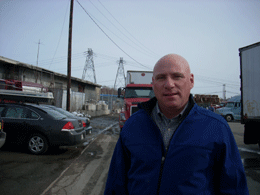
Johnny Gold, a senior vice president for the Recycled Fibers division of the Newark Group, says he has never seen markets for recycled cardboard so low for so long. (Photo: Christine Parrish)
[SOUND OF WALKING DOWN STAIRS]
GOLD: Hi Joey…Oh, buddy…It’s a beautiful day.
[PLANT MACHINE NOISES, FOOTSTEPS]
PARRISH: Gold walks through the loading door to the muddy back lot behind the recycling plant. It’s been raining for days and gray clouds threaten more showers.
[WET FOOTSTEPS]
GOLD: It's bad out here.
PARRISH: But it’s not the weather that troubles Gold.
[SOUND OF TRUCKS BEEPING AND ENGINES REVVING]
PARRISH: Forklifts stack bales of crushed cardboard two stories high in the mud. We walk through a crooked alley past row after row of soggy cardboard.
GOLD: We got bales way down also. I have never seen the likes of this. It is horrible.
PARRISH: Just last summer the recycling business was booming. Used cardboard was going for a record price of 200 dollars a ton. Now, it's selling for less than 50 dollars.
[SOUND OF A HORN]
GOLD: Out there in the yard is a product of today’s recycling world in our industry. We have thousands of tons stored.
PARRISH: And it's not just cardboard that's piling up. Gold has growing mountains of plastic and glass bottles.
GOLD: This thing is pretty simple. It’s textbook economics, supply and demand and people aren’t buying. People are scared. If their jobs are in jeopardy, they’re not going to buy extra products and that’s what’s happened.
PARRISH: Resource Recycling Magazine reports the market for metal is “horrendously low” and paper is ‘going nowhere fast’. Editor Jerry Powell says when the global recession hit last fall, people not only stopped buying computers and flat-screen TV's, there was also little need for the boxes they came in.
POWELL: All of that growth was because of Chinese demand. And when the Chinese market so quickly dropped you were seeing piles of material in California and there are several large Los Angeles processors who have rented warehouse space and then filled it up with bales of material.
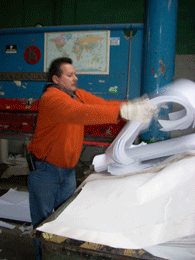
Luis Arorcho, the plant manager for the North Shore recycling plant for the past 28 years, cuts and stacks office paper to be recycled. (Photo: Christine Parrish)
POWELL: Do you know presently that it costs more money to drive a truckload of recyclables across Los Angeles than it costs to put it on a ship in Los Angles harbor and then unload it in Hong Kong. It’s cheaper to go across the ocean than it is across the city.
PARRISH: That has left cities and towns across the U.S. awash in a sea of recyclables. When prices for recycled goods were high, they could recycle trash into cash. Now, with the demand so low, many municipalities have to pay to have it hauled away.
BELING: The dynamics and the economics have changed based on the markets collapsing.
PARRISH: Christine Beling is a project engineer who works on recycling issues in New England for the Environmental Protection Agency.
BELING: In economic downtimes we don’t generate as much garbage, so we don’t generate as much garbage, we don’t generate as much recycling. The trucks go down the streets with less material in them, so it really changes the whole dynamic and the cost structure.
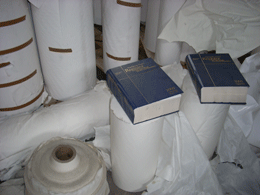
The market for high quality office paper and book leaf paper has not been hit as hard by the recession as lower quality paper products. Ends of rolls and books are recycled back into office paper. (Photo: Christine Parrish)
Jerry Powell of Resource Recycling Magazine says dumping recyclables into landfills hasn’t become a national problem, yet.
POWELL: I am more concerned about what will happen in six months if this deadbeat sort of recycling market continues.
PARRISH: Powell expects a recovery—but not without casualties. Several recycling companies around the country have gone bankrupt, as have some of the world's largest producers of newsprint and cardboard.
[SOUNDS OF RECYCLING LOT]
PARRISH: Third generation recycler Johnny Gold has weathered bad markets before, but nothing like this.
GOLD: [sigh] Well, you need cash. You’re starting every day on a negative and by the end of the day you’re still in a negative if you can’t get the prices up. It makes it extremely stressful. Every day it is another fire that we’re putting out.
PARRISH: Still, as he stands in the lot behind the North Shore Recycling plant where bales of cardboard continue to grow into towers, Johnny Gold remains optimistic. Recycling goes in cycles, he says, we’re just at the bottom of the curve.
GOLD: And we’ll get through it. You have to believe in this industry. I do. I think everybody’s in it. You have to believe in our country. We’ve hit other bricks before. We’ll get through it, but it’s been tough. Real tough.
PARRISH: For Living on Earth, I’m Christine Parrish in Salem, Massachusetts.
[MUSIC: Bill Laswell “Cybotron” from Dub Chamber 3 (Universal-Polygram 2000)]
CURWOOD: You can hear our program anytime on our website, or get a download for your mp3 player. The address is loe.org. That’s L-O-E dot O-R-G. There, you’ll also find pictures and more information about our stories. And we’d like to hear from you. You can reach us at comments@loe.org. Once again, comments-at-L-O-E dot O-R-G. Our postal address is 20 Holland Street, Somerville, Massachusetts, 02144. And you can call our listener line anytime at 800-218-9988. That’s 800-218-9988.
An American Epic

[MUSIC: The Movie Screen Orchestra “Dances With Wolves” from Music From The Westerns (Marathon 2008)]
MCGRATH: Fair set windless, fine and warm.
CURWOOD: Poet Campbell McGrath reading from his new epic, “Shannon: a Poem of the Lewis and Clark Expedition.”
MCGRATH: Clouds at dawn resembling raked embers now diminished nor any wisp to be seen having never conceived a sky so grand as this I wonder if the western ocean truly resembles the accounts Captain Lewis has given, could it be larger still?
CURWOOD: That’s the voice Campbell McGrath imagines for George Shannon – a teenager on Lewis and Clark’s great trek of discovery, charting rivers and mountains and animals across what would become the western half of America.
MCGRATH: George Shannon is just the guy who I fell in love with – in that big grand epic adventure with major heroic figures, George Shannon was kind of like a goofy kid, along for the ride. He was the youngest of the guys of the Lewis and Clark expedition. He was only a teenager, eighteen years old and he had the misfortune to get lost.

Poet Campbell McGrath.
MCGRATH: So after he manages to kill one deer, he’s out of luck. They only had their kind of day’s ration of bullets with them, so he basically survives on pawpaws, plums, berries, currants and slowly feels himself slipping toward starvation.
CURWOOD: Things may be tough, but he rather sets himself some pretty high ambitions.
MCGRATH: Well they’re his ambitions and also there are his father’s ambitions. His father is clearly an ambitious man. So he imagines his father talking to him as he’s speculating on you know politics and the republic “Well, do I know what my father would respond to fancies such as these. Idleness of mind need not be wasted time, George, my boy, if taken up with suitable ambition. George, my boy, if politics be the topic, why not see fit to dream upon President Shannon.”
[LAUGHING]
MCGRATH: So there’s – I don’t suppose every—in other words every eighteen year olds frontiersman was imagining he might be President. It’s the strange fate, though, that Shannon went on to have a very notable political career as did three of his younger brothers, all of these guys being kids who grew up in a log cabin in the frontier. Shannon was a Congressperson in Kentucky. Then he ran for United States Senate in Missouri. So, you know, there was something about this kind of wide open character of the early nineteenth century that often had crazy ambitions, and yet often amazingly realize them.
CURWOOD: Throughout the story of George Shannon, buffalo are – well they’re kind of like these mythical creatures. Shannon is so anxious to see them. And out in the wild on his own, he finally does see them, again and again, big herds of buffalo.
MCGRATH: The Lewis and Clark expedition were actually really interested in finding buffalo, but they had never actually seen one. So Shannon, you know, really is eager for the first day or two he’s like were are they. But then before a few more days had passed, he’s amazed that he could, you know, ever had wished to see a single buffalo when he’s surrounded by tens of thousands.
CURWOOD: So Campbell McGrath, I’d like you to read from where George Shannon describes the buffalo. What is going on in his mind at this point when he describes the buffalo herd?
MCGRATH: This is day fourteen or so. He’s been alone for fourteen days. He’s very hungry. He’s lonely and he’s kind of lost himself a little bit in the landscape. It’s like instead of Shannon discovering the country, the country’s kind of discovering and colonizing him in this strange way. And he almost, you know, loses himself in a trance to the buffalo herd.
“Animals in the darkness, all around me. Huffing and lowing of the buffalo. Sound of their lungs steaming into the light. I am not alone in the darkness. Buffalo. Buffalo. Buffalo. Buffalo. Buffalo. Buffalo. Still dark, but not alone, the great herds pulsing all around me in the darkness, snort and exhalation, stomp and low. Beards of saliva, tongue and forelock rustle in the grass of the buffalo gathering. Heavy stamp of hooves and bodies of the buffalo. Fur thick with burs of brome and sedge grass. Hump rumble. Herd wallow. Gruff in the darkness. Smell of the buffalo strong on the river breeze. Black eyes wide as the western ocean. Great herds of the buffalo all around me. Buffalo. Buffalo. Buffalo. Buffalo. Buffalo. Buffalo. Buffalo. Buffalo. Buffalo. Buffalo. Buffalo. Buffalo. Buffalo. Buffalo. Buffalo. Buffalo. Buffalo. Buffalo. Buffalo. Buffalo. Buffalo. Buffalo. Buffalo. Buffalo. Buffalo. Buffalo. Buffalo. Buffalo. Buffalo. Buffalo. Buffalo. Buffalo. Buffalo. Buffalo. Buffalo. Buffalo. Buffalo. Buffalo. Buffalo. Buffalo. Buffalo. Buffalo. Buffalo. Buffalo. Buffalo. Buffalo. Buffalo. Buffalo. Buffalo. Buffalo. Buffalo. Buffalo. Buffalo. Buffalo. Buffalo. Buffalo. Buffalo. Buffalo. Buffalo. Buffalo. Buffalo. Buffalo. Buffalo. Buffalo. Buffalo. Buffalo. Buffalo. Buffalo. Buffalo. Buffalo. Buffalo. Buffalo. Buffalo.
Herds and eyes all around me in the darkness. Buffalo in the dawn light breathing, whispering, I am the buffalo god. I am the buffalo god. Behold my kingdom.”
CURWOOD: It is so strange that here this young man is nearly starving to death and the land is so abundant.
MCGRATH: Yeah, and I guess you can only go so far on handfuls of, you know, river grapes. But nonetheless he had this endless kind of resource of intelligence and imagination and enterprise and courage to endure what he did. And, you know, at one point he says, “In the land of plenty, I travel hungry. In a country of herds, I wonder alone. On a journey of discovery, I am the lost.”
CURWOOD: You know, there is something kind of sad about both the innocence of George Shannon and really of this land unspoiled, these vast buffalo herds that we know are gonna be gone in not too long after the Lewis and Clark expedition if you think about it.
MCGRATH: Absolutely true. That’s one of the things that is really interesting about reading those, you know, the first hand testaments of – whether its Lewis and Clark or William Bartram or the explorers back then, late 18th century, early 19th century, is we all know where the story’s headed in the longer run. We all know that a vision of exploiting nature is where the country’s going. But so you can at that moment at least still kind of believe in, you know, the possibilities of cherishing the landscape and you can recognize that both of these tendencies continue in American culture, you know, the exploitative as well as the celebratory, and you have to kind of continue to root for the right one.

MCGRATH: You know, Shannon thinks he’s done for. ‘Cause when he gets back to the river, he sees: wow, they’re not here. I really need to hurry to catch up with these guys. Of course, the irony is he’s catching up to people who are behind him. So all the time he’s racing upstream, he’s getting further away from them. And eventually he kind of basically gives up and just stops and sits down by the river. And these are his final thoughts.
“I doubt not but my countrymen will populate in numbers these fulsome plains, but what untold count of years and men, of decades and centuries, what numberless generations will it require, life by life and skeleton by skeleton to claim this land from the buffalo. Who finds this body, be it known, my name is George Shannon. And I bequeath my remains to seed this land with American bones.”
CURWOOD: Campbell, thank for very much.
MCGRATH: Thank you very much. It’s been a real pleasure to be here.
CURWOOD: Campbell McGrath is a poet and writer. He teaches at Florida International University, and his new book is called “Shannon: a Poem of the Lewis and Clark Expedition.”
[MUSIC: The Movie Screen Orchestra “Dances With Wolves” from Music From The Westerns (Marathon 2008)]
Related links:
- For more on poet Campbell McGrath and his epic, “Shannon,” click here.
- For more on what’s known about the historical George Shannon, check out PBS’ website about the Lewis and Clark expedition.
CURWOOD: On the next Living on Earth: how to face America’s threats in the twenty-first century.
HELVARG: We’re no longer in a world in which we can respond to all crisis with guns. We have to be able to respond to an unknowable range of threats in a world that’s two-thirds saltwater and to me that response is best done by the well-trained gals and guys at the Coast Guard.
CURWOOD: The unsung heroes of the federal military - next time on Living on Earth.
[SOUND OF WATER LAPPING]
CURWOOD: We leave you this week at the Vancouver waterfront.
Waves lap against a creaking wharf while the Seabus ferry crosses Vancouver Harbor.
Passengers shuttle between the city of North Vancouver and downtown.
Barry Truax and Hildegard Westerkamp captured these sounds for the CD Soundscape Vancouver 1996.
[SOUND OF SEAPLANES, CREAKING METAL, FOGHORN]
CURWOOD: Living on Earth is produced by the World Media Foundation. Our crew includes Bobby Bascomb, Eileen Bolinsky, Bruce Gellerman, Ingrid Lobet, Helen Palmer, Jessica Ilyse Smith, Ike Sriskandarajah, Mitra Taj and Jeff Young, with help from Sarah Calkins, Marilyn Govoni, Sammy Souza, and Dana Chisholm.
Thanks this week to Erica Peterson and West Virginia Public Broadcasting. Our interns are Annie Glausser, and Lisa Song. Jeff Turton is our technical director. Alison Lirish Dean composed our themes. You can find us anytime at loe.org.
I’m Steve Curwood. Thanks for listening.
Living on Earth wants to hear from you!
Living on Earth
62 Calef Highway, Suite 212
Lee, NH 03861
Telephone: 617-287-4121
E-mail: comments@loe.org
Newsletter [Click here]
Donate to Living on Earth!
Living on Earth is an independent media program and relies entirely on contributions from listeners and institutions supporting public service. Please donate now to preserve an independent environmental voice.
NewsletterLiving on Earth offers a weekly delivery of the show's rundown to your mailbox. Sign up for our newsletter today!
 Sailors For The Sea: Be the change you want to sea.
Sailors For The Sea: Be the change you want to sea.
 The Grantham Foundation for the Protection of the Environment: Committed to protecting and improving the health of the global environment.
The Grantham Foundation for the Protection of the Environment: Committed to protecting and improving the health of the global environment.
 Contribute to Living on Earth and receive, as our gift to you, an archival print of one of Mark Seth Lender's extraordinary wildlife photographs. Follow the link to see Mark's current collection of photographs.
Contribute to Living on Earth and receive, as our gift to you, an archival print of one of Mark Seth Lender's extraordinary wildlife photographs. Follow the link to see Mark's current collection of photographs.
 Buy a signed copy of Mark Seth Lender's book Smeagull the Seagull & support Living on Earth
Buy a signed copy of Mark Seth Lender's book Smeagull the Seagull & support Living on Earth

